
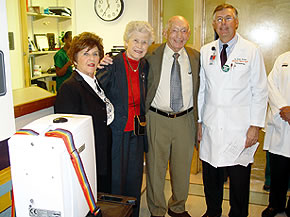 |
||
 |
||
Rosenfields’ Mission supports UM/sylvester
Lasting Friendship
![]() or
50 years, the Rosenfields were friends with Jerry and Bea Taft. “At
least once a month, the four of us were together socially for a game
of gin rummy or a meal. We were friendly with Jerry and Bea, as well
as their children,” says George Rosenfield. “We enjoyed
being with each other through all the good times.”
or
50 years, the Rosenfields were friends with Jerry and Bea Taft. “At
least once a month, the four of us were together socially for a game
of gin rummy or a meal. We were friendly with Jerry and Bea, as well
as their children,” says George Rosenfield. “We enjoyed
being with each other through all the good times.”
Unfortunately, there were bad times too, as Jerry was struck with esophageal cancer. Following the passing of their dear friend, the Rosenfields decided to do something besides mourn his death. “We made it our mission to do something to help patients with the same disease as Jerry,” says Rosenfield.
Recently, the Rosenfields pledged $450,000 to the School of Medicine to augment their original $500,000 gift made in 1998. These two gifts, combined with a third gift of $52,000 to buy a Photo Dynamic Therapy (PDT) laser, brought the couple’s philanthropic commitments to more than $1 million and earned them membership in the prestigious George E. Merrick Society.
The PDT Program was dedicated in memory of Jerry Taft. PDT is used for some patients being treated for esophageal and lung cancer. This noninvasive treatment uses light to treat shallow tumors in sensitive areas of the body, which are hard to reach with conventional surgery.
“In addition to better outcomes, the Rosenfields’ gift of a photodynamic treatment laser allows us to treat patients here in Miami instead of having to refer them elsewhere, such as Jacksonville or Minneapolis,” says Francisco Civantos, M.D., a head and neck surgeon at UM/Sylvester Comprehensive Cancer Center.
The couple’s generosity didn’t stop with honoring Jerry Taft’s memory. When informed that the gastrointestinal suite needed to be expanded, the couple pledged $450,000 to cover the construction costs. “Because of the Rosenfields’ generosity, we will have the potential to double the number of patients seen,” notes W. Jarrard Goodwin, M.D., F.A.C.S., director of UM/Sylvester.
Simon Fireman Charitable Foundation Advances Vision Research
![]() generous
gift from Norma and Simon C. Fireman of Palm Beach and Quincy, Massachusetts,
will help Bascom Palmer Eye Institute continue its leading-edge vision
research. The Firemans have established a research endowment with a
$500,000 gift, while Lawrence J. and Florence DeGeorge of Palm Beach
added a $100,000 gift to the endowment to honor the Firemans and Dick
and Sally Robinson.
generous
gift from Norma and Simon C. Fireman of Palm Beach and Quincy, Massachusetts,
will help Bascom Palmer Eye Institute continue its leading-edge vision
research. The Firemans have established a research endowment with a
$500,000 gift, while Lawrence J. and Florence DeGeorge of Palm Beach
added a $100,000 gift to the endowment to honor the Firemans and Dick
and Sally Robinson.
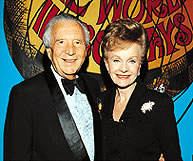 |
||
 |
||
The endowment will provide critically needed support for a number of initiatives at Bascom Palmer. “This endowment is an important component in continuing our scientific work on eye diseases,” says Carmen A. Puliafito, M.D., M.B.A., chairman of Bascom Palmer. “I am delighted that Norma and Simon stepped forward with such a generous gift and also thank Lawrence and Florence De George for their generosity.”
Simon Fireman is the founder, chairman, and CEO of Aqua-Leisure Industries, a manufacturer of recreational swim products and sporting goods.
Scholarship Honors Alumnus and helps students
Class Act
![]() hen
the class of 1964 recently celebrated its 40th class reunion on the medical
campus, they were without one very special class member. His legacy lives
on in the form of the Class of 1964 Peter Lake Endowed Scholarship. Unlike
many graduating classes, rather than give a class gift upon graduation,
the class of 1964 decided to start an endowed scholarship. An especially
close-knit group composed mostly of South Florida students, they were
devastated when popular classmate Peter Lake died in his early 30s. The
class named the endowment in his memory.
hen
the class of 1964 recently celebrated its 40th class reunion on the medical
campus, they were without one very special class member. His legacy lives
on in the form of the Class of 1964 Peter Lake Endowed Scholarship. Unlike
many graduating classes, rather than give a class gift upon graduation,
the class of 1964 decided to start an endowed scholarship. An especially
close-knit group composed mostly of South Florida students, they were
devastated when popular classmate Peter Lake died in his early 30s. The
class named the endowment in his memory.
 The endowment is currently worth almost $356,000,
including $20,000 in income generated during the past fiscal year. Money
is allocated regularly
from the fund for scholarships to medical students.
The endowment is currently worth almost $356,000,
including $20,000 in income generated during the past fiscal year. Money
is allocated regularly
from the fund for scholarships to medical students.
One recipient, Sabine Irene Warren, M.D. ’95, said the scholarship changed her life. Warren, who moved to the United States from Braunschweig, Germany, had a full-time nursing career and three children, but she dreamed of becoming a physician. “The opportunity to fulfill my dream would not have been possible without the generosity of those who gave to this scholarship fund. The award provided the extra assistance to be able to continue on and become a doctor.”
The Peter Lake Endowed Scholarship was the second class scholarship established at the School of Medicine and by far the most successful. Plans are under way to create other class-year endowed scholarships.
College Freshman Becomes UM/Sylvester’s Youngest Founder
Five years ago, Gaines’s mother Joan was diagnosed with breast cancer around the time he was celebrating his bar mitzvah. Instead of spending the monetary gifts he received that day, the 13-year-old took the money and established a fund for cancer research. But Gaines didn’t stop there. A big basketball fan, he thought of a way to boost his research fund with a charity event. So he talked Glen Rice, then of the Miami Heat, into helping with a celebrity basketball game that raised $10,000. As a senior at Gulliver Preparatory Academy, Gaines organized his third NBA fundraiser with help from the Miami Heat and the University of Miami men’s basketball program. Gaines’s efforts paid off last summer when he delivered a check for $21,700 to W. Jarrard Goodwin, M.D., F.A.C.S., director of the University of Miami Sylvester Comprehensive Cancer Center, and Joyce Slingerland, M.D., Ph.D., director of the Braman Family Breast Cancer Institute at UM/Sylvester to help support Slingerland’s work. As a result of this gift and pledges, Gaines is the youngest member of the Founders Society. As for Gaines’s mom, she just had a celebration of her own. She has been cancer-free for five years. |
$20 Million Raised for Research Programs
Life-Saving Friends For Life
“To build oneself into the structure of undying institutions, to aid in the development of priceless instruments of civilization, is to have lived, not in vain, but to have lived in perpetuity.”
—Elihu Root, 1912 Nobel Peace Prize winner
![]() hances
are the late Bea Dossick never met Elihu Root, but his observation and
her philosophy were closely linked. In 1974 Dossick, associate dean emerita,
founded Friends For Life, a nonprofit, volunteer organization dedicated
to raising funds to advance life-saving programs at the University of
Miami Center for Research in Medical Education (CRME).
hances
are the late Bea Dossick never met Elihu Root, but his observation and
her philosophy were closely linked. In 1974 Dossick, associate dean emerita,
founded Friends For Life, a nonprofit, volunteer organization dedicated
to raising funds to advance life-saving programs at the University of
Miami Center for Research in Medical Education (CRME).
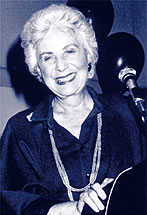 |
||
 |
||
Since its inception, Friends For Life has raised more than $20 million for the University of Miami School of Medicine, contributing to the success of far-reaching programs that have improved medical education and health care. Recently the organization announced a gift of $1.5 million to support the expansion of research programs in medical education at the new CRME, now under construction.
Previous funding supported “Harvey,” the world-renowned cardiology patient simulator, and life-saving emergency medical skills training programs in heart attack and stroke for paramedics. Other efforts have supported scholarships and research in ophthalmology, cochlear implants, pediatrics, obstetrics and gynecology, cancer, orthopedics, adult development and aging, and heart disease in women.
This three-decade-plus relationship grew out of Dossick’s vision. Back in the mid-’70s, snowbirds and retirees were flocking to South Florida. As people settled into their new communities, lives, and activities, they maintained their dependence on physicians and medical facilities up north. Their allegiance and fundraising for these northern medical concerns continued in Florida, yet in time of medical need the distance proved to be unrealistic for access to prompt medical attention.
 Dossick had an idea: Why not channel the expertise
of medical fundraising and interest of this population group along
with their need for quality,
accessible medical facilities? Thus, Friends For Life was born, dedicated
to providing vital financial support to the University of Miami School
of Medicine’s research programs. In return, the organization received
referrals to physicians at the medical campus.
Dossick had an idea: Why not channel the expertise
of medical fundraising and interest of this population group along
with their need for quality,
accessible medical facilities? Thus, Friends For Life was born, dedicated
to providing vital financial support to the University of Miami School
of Medicine’s research programs. In return, the organization received
referrals to physicians at the medical campus.
Today Friends For Life has grown to 2,500 families with four chapters in Miami-Dade, Broward, and Palm Beach counties. In 2001 Friends For Life pledged $1 million to the CRME for its initial development and implementation of an anti-terrorism curriculum for emergency medical services and hospital-based health care workers. According to Diane Issenberg, CRME director of administration and fiscal affairs and Friends For Life liaison, “This seed money directly resulted in the state and the federal government funding this program two years later. The state of Florida Department of Health designated the CRME as the lead center for statewide first-responder antiterrorism training, and the U.S. Army chose us to train their Forward Surgical Teams prior to their frontline deployment.”
David Lee Gordon, M.D., assistant director of the CRME, notes, “The members of Friends For Life have made significant contributions in numerous areas. One of the most critical contributions is to our emergency programs on stroke and heart attacks.”
Dossick envisioned an organization that in its support for the School of Medicine would help improve the quality of life for its members. “Bea believed that one of the greatest things her generation could do was to lay stepping stones for the next generation,” Issenberg says.
Her efforts certainly will live in perpetuity.
Online Giving made easy
It’s Just a Click Away

![]() rom
booking vacations to ordering movie tickets—and everything
in between—the Internet has made life easier. Add making a
contribution to the University of Miami School of Medicine via your
computer to
the list of quick and convenient things you can now do online.
rom
booking vacations to ordering movie tickets—and everything
in between—the Internet has made life easier. Add making a
contribution to the University of Miami School of Medicine via your
computer to
the list of quick and convenient things you can now do online.
Marsha Kegley, interim assistant vice president for medical development and alumni affairs, notes, “The Web is a wonderful tool for raising dollars in a most efficient manner. But it has not yet reached its full potential.” Things are changing, both in terms of the dollars raised and the number of organizations using Web sites for fundraising. According to the Association of Fundraising Professionals, annual Web giving grew 50 percent from 2002 to 2003, and the expectation is that billions will be given online in the coming year.
Cliff Stamler, M.D. ’77, a radiologist at Miami’s Baptist Hospital, recently made an online gift to his alma mater. “I found it quick and easy to contribute online,” Stamler says. “I got the satisfaction of knowing the School of Medicine received my gift immediately.”
Interested in giving online? It’s easy and takes just a few minutes. Visit www.miami.edu/campaign.
Committed to Advancing Medicine PERSONAL BACKGROUND: John Schulte retired to private investing following a distinguished 40-year career as a public relations counselor in South Florida. In addition to managing an impressive array of professional clients, John served on the board of the largest federal savings bank headquartered in Florida, a commercial bank, and the management company of an international mutual fund. Judy is a former flight attendant with 30 years at Eastern Airlines. In 2001 John joined the Board of Governors of the Sylvester Comprehensive Cancer Center/UM Hospital and Clinics. He has also been a member of UM’s honor society, Iron Arrow, for the past 50 years. GIFT: The Schultes’ most recent gift was $1 million to UM/Sylvester. They are already members of the George E. Merrick Society in recognition of their contributions to the School of Medicine for cancer research, the Ear Institute’s deafness research project, and a cardiovascular research project. GIVING PHILOSOPHY: We, and that means everyone, have a responsibility to share the commitment to improve life. Make that commitment and follow through on it year after year after year. We both came from modest backgrounds, and along the way we have been blessed to be able to make extraordinary contributions to such important causes. ON MAKING A DIFFERENCE: University of Miami physicians treat thousands of patients annually. At the same time, they are teaching UM medical students who will be among the next generation of outstanding doctors. They spend countless hours, day and night, in UM research labs, combining the latest scientific results with their clinical results. How can anyone not donate at the highest level of their individual capacity to support this outstanding group commitment? WHAT THE MEDICAL SCHOOL MEANS TO US: The School of Medicine stands on the cutting edge of delivering a better tomorrow. In only 50 years, it has grown and prospered into one of the leading academic medical institutions in this country. As such, it is now one of the single greatest assets of the South Florida community. We are proud to be active participants in this, the most exciting and defining time for the advance of medical knowledge. |
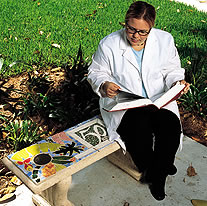 |
||
 |
||
Medical Faculty Association marks 50 years
Enduring Support
![]() ifty
years ago, at the School of Medicine’s first home in The Biltmore
Hotel, a group of 21 women established the Medical Faculty Wives, now
called the Medical Faculty Association (MFA).
ifty
years ago, at the School of Medicine’s first home in The Biltmore
Hotel, a group of 21 women established the Medical Faculty Wives, now
called the Medical Faculty Association (MFA).
“Two years after the medical school opened its doors we began our group,” says Any Muench, current president. “At first the emphasis was on offering support to spouses and helping the wives adjust to the area and life as the spouse of a physician.” Soon the organization took on the responsibility of raising money for various projects and scholarships.
One of the earliest fundraising projects was selling Christmas trees. A benefit tea in 1958 raised $500, which was donated to a short-term medical student loan fund. Maja Slotta, one of the early organizers, secured federal funds that matched donations nine to one, facilitating the initial growth of the student loan fund.
“From that date forward, providing financial assistance to medical students became one of the organization’s primary objectives,” Muench says. The loan fund was recently converted to an endowment fund from which scholarships will be granted to needy medical students. This year the group raised a record $54,000, most of it at their Golden Gala held at The Biltmore Hotel last spring.
Not only does the association support medical school and nursing scholarships, it also established a Graduate Student Loan Fund through the efforts of Margaret Whelan, the late wife of William Whelan, D.Sc., professor and chairman emeritus of the Department of Biochemistry and Molecular Biology. Another fund, the MFA Margaret Whelan Graduate Student Scholarship Fund for competitive research travel awards, was later established in honor of her dedication to the medical school and the organization.
In 1997 the group spearheaded a two-year fundraising campaign and won a $150,000 grant from the state of Florida to restore Halissee Hall. The MFA also has raised funds to renovate the waiting room of the Medical Intensive Care Unit at Jackson Memorial Hospital. Last year the MFA designed and created two decorative benches on the Schoninger Research Quadrangle in honor of the medical school’s 50th anniversary.
As Any Muench reflects on the group’s own 50th anniversary, she is proud of the initial group of 21 people who planted the seeds for today’s MFA. “Today we have 156 members, including Edith Reiss, the only original member,” she says. “Our accomplishments honor all the dedicated women who have made the MFA an important part of the School of Medicine’s fabric.”
For information on joining the Medical Faculty Association, call Any Muench at 305-856-8308.
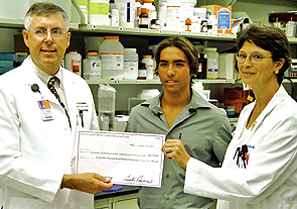

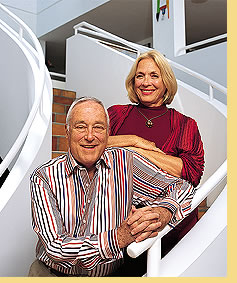
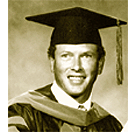 Medical
School Mourns Loss of a Hero
Medical
School Mourns Loss of a Hero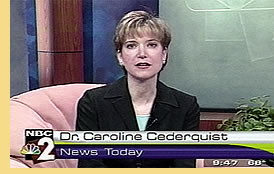 ACCOMPLISHMENTS:
ACCOMPLISHMENTS: